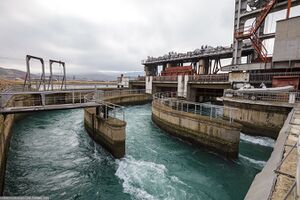Water intake: различия между версиями
| Строка 6: | Строка 6: | ||
==Определение на английском== | ==Определение на английском== | ||
Structure or site, the purpose of which is to control, regulate, divert, and admit water directly from the source, through an inlet built upstream.<ref>World Meteorological Organization (WMO), United Nations Educational and Scientific Organization (UNESCO). International Glossary of Hydrology // IHP/OHP-Berichte. 1998. № 385. 461 p.</ref> | Structure or site, the purpose of which is to control, regulate, divert, and admit water directly from the source, through an inlet built upstream.<ref>World Meteorological Organization (WMO), United Nations Educational and Scientific Organization (UNESCO). International Glossary of Hydrology // IHP/OHP-Berichte. 1998. № 385. 461 p.</ref> | ||
| + | |||
| + | Water intake is a term to describe the process of extraction or withdrawal of water from a natural source such as a river, lake, or reservoir for various purposes such as human consumption, irrigation, industrial uses, or other water-related activities.<ref>Environmental Protection Agency (EPA), Glossary of Water Terms, 2016</ref> | ||
==Пример использования термина на английском языке== | ==Пример использования термина на английском языке== | ||
At the same time, many water intakes have no protected sanitary zones.<ref>Szpak D. et al. Risk assessment of water intakes in south-eastern poland in relation to the who requirements for water safety plans // Resources. 2021. Vol. 10, № 10.</ref> | At the same time, many water intakes have no protected sanitary zones.<ref>Szpak D. et al. Risk assessment of water intakes in south-eastern poland in relation to the who requirements for water safety plans // Resources. 2021. Vol. 10, № 10.</ref> | ||
| + | |||
| + | The area of indirect protection of the groundwater intake covers the water intake area. <ref>Tchórzewska-Cieślak, B.; Szpak, D. A Proposal of a Method for Water Supply Safety Analysis and Assessment. Ochr. Sr. 2015, №37, р. 43–47.</ref> | ||
==Перевод использования на русском языке== | ==Перевод использования на русском языке== | ||
Версия 01:38, 26 апреля 2024

Водозабор
Гидротехническое сооружение для изъятия воды из рек или других водных объектов для нужд водоснабжения, энергетики, ирригации, отвода паводковых вод. Забор воды из реки нарушает ее водный режим, приводит к изменению русловых процессов; сами сооружения требуют учета русловых деформаций, которые могут привести к нарушению нормального функционирования (например, из-за обмеления участка реки, где расположен водозабор), вызывают необходимость выполнения регуляционных мероприятий, обеспечивающих их предотвращения.[2]
Определение на английском
Structure or site, the purpose of which is to control, regulate, divert, and admit water directly from the source, through an inlet built upstream.[3]
Water intake is a term to describe the process of extraction or withdrawal of water from a natural source such as a river, lake, or reservoir for various purposes such as human consumption, irrigation, industrial uses, or other water-related activities.[4]
Пример использования термина на английском языке
At the same time, many water intakes have no protected sanitary zones.[5]
The area of indirect protection of the groundwater intake covers the water intake area. [6]
Перевод использования на русском языке
В то же время вокруг многих водозаборов не созданы защитные санитарные зоны.
Список литературы
- ↑ https://russos.livejournal.com/945146.html
- ↑ Чалов Р. С. Толковый терминологический и понятийный словарь-справчник по русловедению. — Типография "Ваш формат". Москва, 2022. — 142 с.
- ↑ World Meteorological Organization (WMO), United Nations Educational and Scientific Organization (UNESCO). International Glossary of Hydrology // IHP/OHP-Berichte. 1998. № 385. 461 p.
- ↑ Environmental Protection Agency (EPA), Glossary of Water Terms, 2016
- ↑ Szpak D. et al. Risk assessment of water intakes in south-eastern poland in relation to the who requirements for water safety plans // Resources. 2021. Vol. 10, № 10.
- ↑ Tchórzewska-Cieślak, B.; Szpak, D. A Proposal of a Method for Water Supply Safety Analysis and Assessment. Ochr. Sr. 2015, №37, р. 43–47.